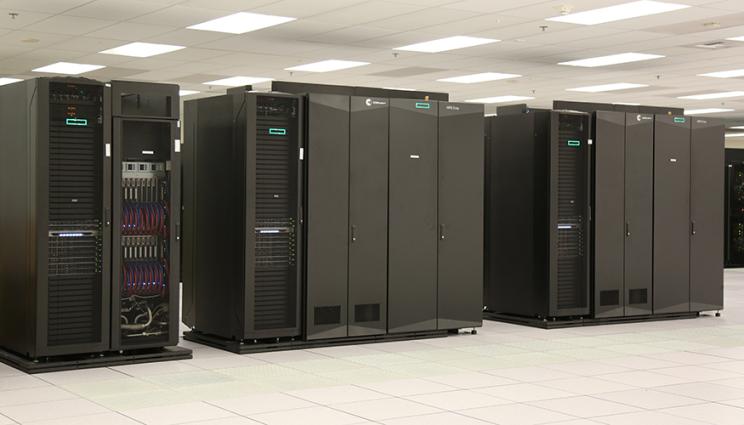
Three testbed machines for Lawrence Livermore National Laboratory's future exascale El Capitan supercomputer - nicknamed rzVernal, Tioga and Tenaya - all ranked among the top 200 on the latest Top500 List of the world's most powerful computers, released at the International Supercomputing Conference on May 30. Credit: Katrina Trujillo/LLNL.
As the U.S. welcomed the world's first "true" exascale supercomputer, three predecessor machines for Lawrence Livermore National Laboratory's (LLNL) future exascale system El Capitan managed to rank highly on the latest Top500 List of the world's most powerful supercomputers.
Organizers announced the list at the International Supercomputing Conference in Hamburg, Germany on May 30.
Despite being "testbed" machines for El Capitan, the National Nuclear Security Administration's first exascale supercomputer, the three early access systems - rzVernal, Tioga and Tenaya - all ranked in the top 200 worldwide.
Of the three, rzVernal was the highest at No. 123, with a peak on the High Performance Linpack (HPL) benchmark of 4.1 petaFLOPs (4.1 quadrillion floating point operatons per second) - the HPL score reflects system performance for solving a dense system of linear equations. Tioga placed No. 135 on the list, with a Linpack score of 3.67 petaFLOPs (PF), and Tenaya achieved 2.86 PF, good enough for the No. 200 slot.
All three early access systems are built by Hewlett Packard Enterprise and contain HPE Cray EX235a accelerator blades with 3rd Generation AMD EPYC 64-core CPUs and AMD Instinct MI250X accelerators - including some components that will eventually comprise El Capitan. El Capitan is expected to surpass two exaFLOPs (two quintillion floating point operations per second) after it is accepted at LLNL in 2023. With the addition of the new machines, LLNL now boasts nine systems on the bi-annual list, more than any other high performance computing (HPC) center in the U.S.
"We're proud to add three more machines to the Top500 List of the world's most powerful supercomputers, where we were already well represented," said Chief Technology Officer for Livermore Computing Bronis R. de Supinski. "The list continues to reflect the Lab's sustained excellence in leading-edge HPC worldwide, and we look forward to continued success in the era of exascale supercomputing."
The latest Top500 List marked the debut of the first-ever system to demonstrate a peak performance of more than one exaFLOP, the HPE Cray system Frontier at Oak Ridge National Laboratory (ORNL). Frontier captured the No. 1 slot with an HPL of 1.102 exaFLOP, staking its claim as the world's "first true exascale machine," according to Top500 organizers.
The previous top-ranked supercomputer in the world, Fugaku at the RIKEN Center for Computational Science in Japan, dropped to No. 2, matching its previous HPL score of 442 petaFLOPs. A new entrant on the list, the LUMI system at EUROHPC/CSC in Finland, the largest and fastest system in Europe, took the No. 3 spot with a HPL benchmark of nearly 152 PF. Also new to the Top 10 was the Adastra system at France's GENCI-CINES computing center, achieving 46.1 PF to No. 10 overall.
LLNL's heterogeneous IBM/NVIDIA machine Sierra, NNSA's flagship supercomputer, dropped to No. 5 at 94.6 PF, behind ORNL's similarly architected IBM/NVIDIA supercomputer Summit at 148.8 PF.
Other LLNL machines making the list included Lassen, Sierra's unclassified companion system, which fell to No. 30 at 18.2 PF. The Intel/Supermicro cluster Ruby achieved 3.7 petaFLOPs on the HPL, ranking it No. 134 in the world, ahead of LLNL's Penguin/Intel cluster Magma to No. 157 at 3.24 petaFLOPs. The Penguin/Intel commodity clusters Jade and Quartz placed back-to-back at 233 and 234, respectively.
The Top500 list is compiled by Erich Strohmaier and Horst Simon of Lawrence Berkeley National Laboratory; Jack Dongarra of the University of Tennessee, Knoxville; and Martin Meuer of ISC Group, Germany.
To view the complete list, visit the web.






